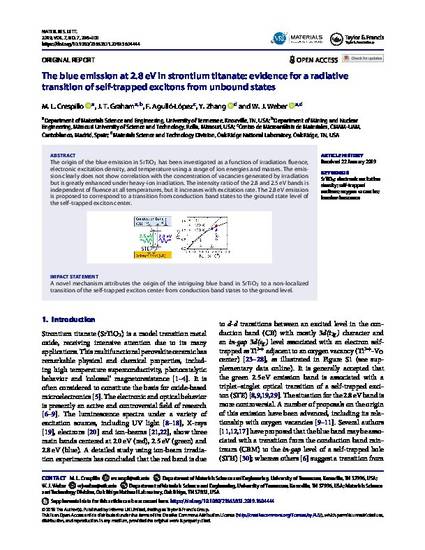
Article
The Blue Emission at 2.8 EV in Strontium Titanate: Evidence for a Radiative Transition of Self-Trapped Excitons from Unbound States
Materials Research Letters
Abstract
The origin of the blue emission in SrTiO3 has been investigated as a function of irradiation fluence, electronic excitation density, and temperature using a range of ion energies and masses. The emission clearly does not show correlation with the concentration of vacancies generated by irradiation but is greatly enhanced under heavy-ion irradiation. The intensity ratio of the 2.8 and 2.5 eV bands is independent of fluence at all temperatures, but it increases with excitation rate. The 2.8 eV emission is proposed to correspond to a transition from conduction band states to the ground state level of the self-trapped exciton center.
Department(s)
Nuclear Engineering and Radiation Science
Comments
This work was supported by the U.S. Department of Energy, Office of Science, Basic Energy Sciences, Materials Sciences and Engineering Division under Contract DE-AC05-00OR22725.
Keywords and Phrases
- Electronic Excitation Density,
- Ionoluminescence,
- Oxygen Vacancies,
- Self-Trapped Excitons,
- SrTiO3
Document Type
Article - Journal
Document Version
Final Version
File Type
text
Language(s)
English
Rights
© 2019 The Authors, All rights reserved.
Publication Date
7-1-2019
Publication Date
01 Jul 2019
Disciplines
Citation Information
Miguel L. Crespillo, Joseph T. Graham, Fernando Agullo-Lopez, Y. Zhang, et al.. "The Blue Emission at 2.8 EV in Strontium Titanate: Evidence for a Radiative Transition of Self-Trapped Excitons from Unbound States" Materials Research Letters Vol. 7 Iss. 7 (2019) p. 298 - 303 ISSN: 2166-3831 Available at: http://works.bepress.com/joseph-graham/52/
